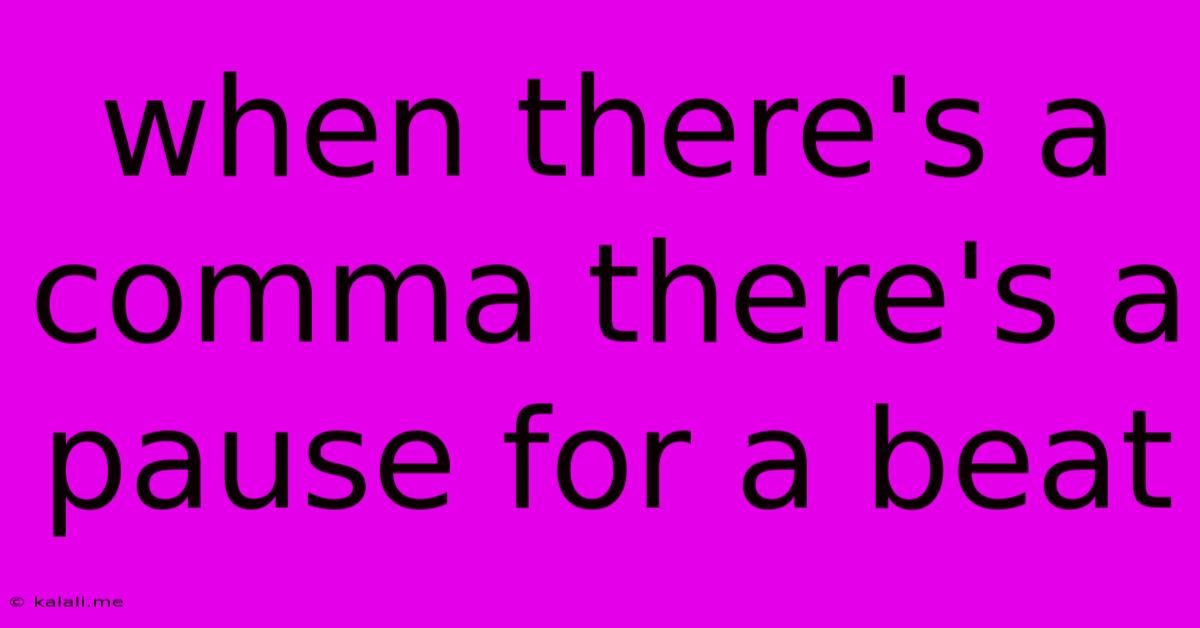When There's A Comma There's A Pause For A Beat
Kalali
Jun 07, 2025 · 3 min read

Table of Contents
When There's a Comma, There's a Pause (for a Beat): Mastering Punctuation for Clarity and Flow
Commas. Those tiny little marks often overlooked, yet they hold the power to transform a sentence from a jumbled mess into a masterpiece of clarity and rhythm. Understanding their function goes beyond simple grammar rules; it's about crafting compelling narratives and ensuring your writing flows effortlessly. This article delves into the nuanced world of commas, exploring when and why they demand a "pause for a beat" in your writing.
Why Commas Matter: More Than Just Grammar
While grammar textbooks might define a comma as a punctuation mark indicating a pause, its true significance extends far beyond a mere breath. A well-placed comma guides the reader's eye, clarifies meaning, and enhances the overall readability of your text. Conversely, misplaced or missing commas can lead to confusion, ambiguity, and even unintentional humor. Mastering comma usage is crucial for effective communication, whether you're crafting a blog post, a novel, or a simple email.
The Key Roles of the Comma: A Breakdown
Commas serve several crucial roles, each demanding that subtle pause:
-
Separating Items in a List: This is perhaps the most common use. Think: "I need milk, eggs, bread, and cheese from the store." Each item receives its own pause before the next. Note the Oxford comma (the comma before "and" – its use is a stylistic choice, but consistency is key).
-
Joining Independent Clauses: When two complete sentences are joined together with a coordinating conjunction (and, but, or, nor, for, so, yet), a comma precedes the conjunction. Example: "The sun was shining brightly, and the birds were singing sweetly." The comma indicates a natural break between the two independent thoughts.
-
Setting Off Introductory Elements: Phrases or clauses that begin a sentence often need a comma after them. For example: "Despite the pouring rain, the game continued." or "After a long day at work, I finally relaxed." The comma signals the end of the introductory element.
-
Setting Off Nonrestrictive Clauses and Phrases: These clauses add extra information, but aren't essential to the sentence's core meaning. They are set off with commas. For instance: "My brother, who is a doctor, works at the city hospital." Removing "who is a doctor" doesn't change the sentence's basic meaning. Restrictive clauses (essential information) do not require commas.
-
Separating Coordinate Adjectives: These are adjectives that equally modify the same noun. Example: "The tall, dark stranger entered the room." Each adjective deserves its individual pause. However, if the adjectives are cumulative (one modifies the other), no comma is needed.
The Rhythm of Commas: Enhancing Readability
Beyond grammatical correctness, commas contribute to the rhythmic flow of your writing. They create natural pauses that mirror the intonation of spoken language, making your text more engaging and easier to read. Consider the difference between these two sentences:
- "The quick brown fox jumps over the lazy dog." (monotonous)
- "The quick, brown fox, jumps over the lazy, dog." (more rhythmic and engaging – although arguably overdone in this example)
The second sentence, while potentially grammatically incorrect in its comma usage, demonstrates how strategic comma placement can create a more pleasant reading experience by introducing variations in pace.
Avoiding Comma Splices and Run-on Sentences
Incorrect comma usage can lead to comma splices (joining two independent clauses with only a comma) or run-on sentences. These errors disrupt the flow of your writing and make your text difficult to understand. Always ensure that you're using appropriate punctuation to connect independent clauses – semicolons or conjunctions are preferable to relying solely on a comma.
Conclusion: The Unsung Hero of Clarity
The comma, often underestimated, is a powerful tool in the writer's arsenal. By understanding its various functions and mastering its subtle nuances, you can craft clearer, more engaging, and more impactful writing. Remember: when there's a comma, there's a pause – a beat that enhances the rhythm and comprehension of your work. So, embrace the comma, and let it elevate your writing to new heights.
Latest Posts
Latest Posts
-
Consider Using The User Option Or Check The Permissions
Jun 07, 2025
-
Animals With Highest Intelligence In 5e
Jun 07, 2025
-
15 Amp Gfci Breaker Keeps Tripping
Jun 07, 2025
-
How Do I Find Cubic Inches
Jun 07, 2025
-
Steam Faimly Group Cant Acsess Dlc
Jun 07, 2025
Related Post
Thank you for visiting our website which covers about When There's A Comma There's A Pause For A Beat . We hope the information provided has been useful to you. Feel free to contact us if you have any questions or need further assistance. See you next time and don't miss to bookmark.